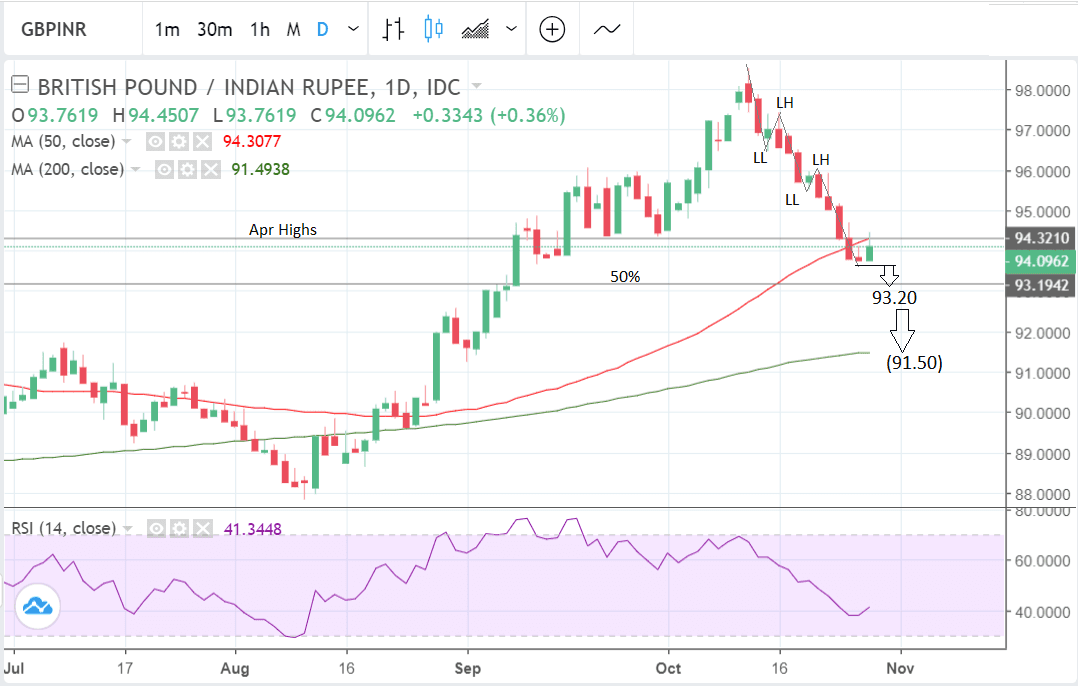Indian Rupee Turns Bullish Against the Pound
- Written by: Gary Howes
-

Image © Kriangkrai, Adobe Stock
- GBP/INR may have started a new trend
- More downside might be on the cards
The Pound's strong uptrend against the Indian Rupee has reversed and the GBP/INR pair is probably now in a new short-term downtrend.
Given trends are more likely to extend than not, the reversal implies a bearish bias to the outlook.
The trend is down because the sequence of bullish peaks and troughs has reversed and the pair has started a new sequence lower. The pair has formed two 'lower lows' and 'lower highs' on the daily chart.
Another bearish sign is that GBP/INR recently broke below the April highs at 94.32 and the 50-day moving average (MA) at 94.31. The current exchange rate is 94.09.
There is a phenomenon in financial markets in which previous support levels turn into future resistance levels after they are broken, and it looks like this may be happening on GBP/INR, with 94.31-32 bar now transforming into a resistance level which could cap upside.
We see a propensity for more downside despite the previous strong medium-term bull trend. A break below the 93.75 lows would provide confirmation of an extension lower, to a new target at 93.20, at the midpoint, or 50% Fibonacci level of the previous uptrend.
At that level, the exchange rate might stall.
A break below the 50% retracement level would signal an even stronger continuation down to the next target at the 200-day at 91.50.
What to Watch This Week
From a fundamental perspective, the main influence on the Indian Rupee comes from oil prices since the country has to import most of its fuel requirements and this accounts for a quarter of all its imports.
The Rupee's recent weakness was as much to do with the rise in oil prices as the strong Dollar - or perceived emerging market risks from a twin deficit. One part of the twin deficit was caused, anyway, mainly because of increasing oil prices.
Oil prices started moving lower on October 10 and this fairly closely correlates with the fall in GBP/INR, albeit with a few days delay.
(Image courtesy of Investing.com)
The main data releases in the week ahead for the rupee are the Nikkei manufacturing and services PMI surveys for October. Manufacturing is forecast to drop 51.9 from 52.2. Services came out at 50.9 previously.
PMI's are seen as reliable leading indicators for the economy.
The Pound remains under pressure from Brexit uncertainty. This is likely to continue until a deal is done, which is probably not in the week ahead.
The main event for Sterling is the Bank of England (BOE) rate meeting and inflation report on Thursday, although the BOE is constrained in its policy options by Brexit uncertainty too.
Nevertheless, a marked rise in inflation expectations could boost the Pound as it would sow the seeds of future rate hikes.
The current view is that the next increase will not be until May 2019, and the BOE will raise rates on average twice a year for the foreseeable future.
Advertisement
Bank-beating exchange rates: Get up to 5% more foreign exchange by using a specialist provider to get closer to the real market rate and avoid the gaping spreads charged by your bank when providing currency. Learn more here

